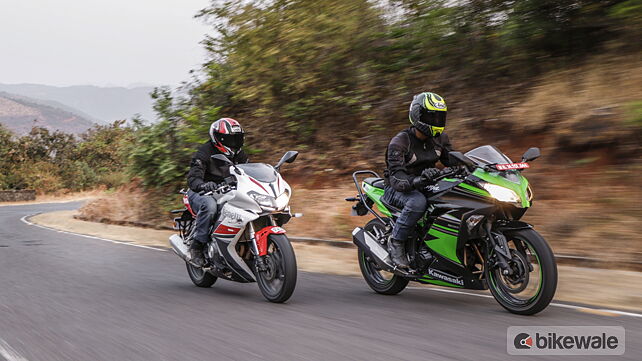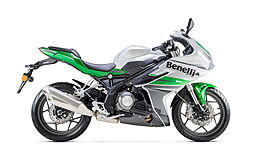Benelli 302R vs Kawasaki Ninja 300

We should have compared these two motorcycles a while ago. The Benelli 302R and the Kawasaki Ninja 300 are, after all, most compared against each other. But, the Kawasaki press bike wasn’t available in BS-IV form for the longest time. And, when it was, we were bombarded with other new motorcycles and scooters, which pushed the 302 vs 300 test right to the back of the line.

But, now they are here. And, it seemed like a head-to-head test that was too close to call by the seat of the pants. Thankfully, BikeWale’s point system came to the rescue and we have a clear winner. But, we will get to that in a bit. First, let’s see how these fared against each other.

The Introductions

The Benelli is the newer bike here. Although, this is more in terms of launch date than technology or engineering. It uses a tubular frame for a chassis and a tubular swingarm, both of which contribute handsomely to the bike’s portly kerb weight.

Suspension duties are handled by upside down forks at the front and a non-linked monoshock at the rear, while the brakes are disc setups at both ends. However, unique to this class is the use of smaller, but twin discs, at the front wheel. The Benelli also comes with ABS as standard.

The engine meanwhile is a liquid-cooled, fuel injected, 300cc, parallel twin. It makes around 38 horsepower and 26.5Nm of torque. The engine is mated to a 6-speed gearbox and the bikes runs a 44 teeth rear sprocket, which should help with its acceleration. It is one of the largest sprockets in its class.

The Ninja 300 runs a 42 teeth rear sprocket. But, it also uses a 6-speed gearbox. And when it comes to performance, it boasts of similar specs. It has a 296cc, parallel twin motor, which like the 302R, is liquid-cooled, fuel-injected and gets a 4-valve head. What’s more, the two share almost identical outputs. The Ninja develops 39bhp and 27Nm.

The Kawasaki, though, is lighter. It uses a tubular frame for a chassis as well, but it’s lighter and stiffer, and the swingarm is a more modern design as well. Plus, the Ninja has a linked monoshock. And even though it gets skinnier ‘right-way-up’ front forks, these are lighter. Brakes, in typical entry-level supersports fashion, include a large single disc upfront and a smaller single disc at the rear.

As far as features go, the Benelli offers more. It gets an adjustable brake lever and high-end tyres in Metzellers. And even though both bikes get digital instrumentation with an analogue tacho, the 302R gets a gear indicator, which is missing on the Kawasaki. However, the Ninja’s clocks look much better and the quality levels on the Kawasaki are better as well.

Game play

So, what does all this translate into, in the real world? For starters you get two very different motorcycles from the same genre.
The Kawasaki is the truer supersports bike here. It has all the necessary pre-requisites. It has a hard seat, a more committed seating triangle, and a more uncomfortable and stiffer suspension setup. And yes, it is lighter too. Besides, it has a sharper steering geometry.

Not surprisingly then, the Ninja feels crisper, more stable, and more talkative around corners. Tip-in into corners is quicker and more progressive. And courtesy its taller cornering clearance, it can carry higher cornering speeds too.
There’s good grip from the tyres as well. But, if we had to nitpick, we’d say the brakes could have had more bite. And, it should have come with ABS as standard; not to aid cornering, but to better justify its pricey tag.

The Benelli gets ABS as standard. And the bite offered by the brakes isn’t bad either. But, for all its Ninja matching power and torque outputs, and a bigger rear sprocket, it is still the slower of the two bikes. It might sound faster, yes, which is great for a while, but put them head-to-head in a drag, and the sharper dressed Ninja pulls away.
However, despite its friendlier seating – it has lower and more forward set footpegs, and a relatively taller handlebar compared to the Kawasaki – it isn’t too bad around corners. Yes, compared to the Ninja it feels longer and softer and bendier. And, it runs out of lean clearance a lot sooner as well. But, unless you love ‘knee-down’ cornering – which in hindsight you must, to even consider a supersport – you can live with it.

Come to think of it, living with the 302R on a daily basis is a lot easier than the Ninja 300. Barring parking, of course – the Benelli does weigh nearly 200kg. The 302R has a softer ride and seat, meaning it is more comfortable over our less than perfect city roads. The more upright seating makes it a better machine to tour and commute on.
And its better low-end grunt makes for a more relaxed motorcycle to ride when fetching a loaf of bread. It could do with a lighter clutch pull though, which the Ninja has. Also, if we had to pick a bike for better refinement levels, it would be the Ninja. What’s more, the gearshifts are crisper and more precise on the Kawasaki as well.

Having said all that, when it was time to ride back to base, a near 200km ride, after two days of riding and shooting in the heat and dust, I went for the Benelli keys. Call me old if you will, but I wanted comfort over handling prowess for the last leg home.
Verdict

Besides comfort – and let’s not forget ABS and an adjustable brake lever – the Benelli can’t match up to the Kawasaki. The Ninja 300, infamous for being pricey for a 300cc motorcycle, is the better looking, better handling, and better-engineered motorcycle. It’s lighter and quicker as well.

Now, even though the Ninja isn’t as comfortable as the 302R, it’s not exactly KTM uncomfortable either. Meaning, you could commute on it every day if you like; it’s just that you might need slightly stronger core muscles than you would to ride the 302R.

But, what finally seals the win in the Japanese’s favour is the Benelli’s price. It’s only Rs 20,000 cheaper than the Ninja, which at an asking price of around Rs 4 lakhs is a difference of just five per cent. I guess the Ninja isn’t the only infamous, pricey bike on sale currently.

Photography by Kaustubh Gandhi
Final Scores
| Parameters | Max Points | Kawasaki Ninja 300 | Benelli 302R |
|---|---|---|---|
| Rank | 1 | 2 | |
| Looks & styling | 10 | 8.5 | 7.5 |
| Ergonomics & Quality | 10 | 7.5 | 6.5 |
| Features & Tech | 10 | 6.5 | 7 |
| Engine & Gearbox | 10 | 7 | 7 |
| Performance | 10 | 8 | 7 |
| Ride Quality | 10 | 6 | 7 |
| Handling & Braking | 10 | 7.5 | 6.5 |
| Fuel Efficiency | 10 | 4 | 3.5 |
| Price & Warranty | 10 | 3 | 3 |
| Desirablility | 10 | 8 | 7 |
| Total | 100 | 66 | 62 |
Specifications
| Make | Kawasaki | Benelli |
|---|---|---|
| Model | Ninja 300 | 302R |
| POWER TRAIN | ||
| Engine Type | Liquid-cooled | Liquid-cooled |
| Capacity | 296cc | 300cc |
| Max Power | 38.5bhp | 38.2bhp |
| Max Torque | 27Nm | 26.5Nm |
| Gearbox | Six-speed | Six-speed |
| Clutch | Wet, multiplate with slipper clutch | Wet, multiplate |
| Fuel Efficiency | 29.1kmpl | 26kmpl |
| CYCLE PARTS | ||
| Chassis | Diamond | Trellis |
| Supension F | 37mm telescopic forks | 41mm inverted forks |
| Suspension R | Bottom link monoshock | Monoshock |
| Brakes F | 290mm disc | Dual 260mm discs with ABS |
| Brakes R | 220mm disc | 240mm disc with ABS |
| Tyre F | 110/70-R17 Tubeless | 110/70-R17 Tubeless |
| Tyre R | 150/60-R17 Tubeless | 150/60-R 17 Tubeless |
| MEASURES | ||
| Fuel Tank | 17 litres | 14 litres |
| LxWxH | 2015mm x 715mm x 1170mm | 2150mm x 745mm x 1115mm |
| Wheelbase | 1405mm | 1410mm |
| Kerb Weight | 172kg | 198kg |
| COST | ||
| Price (on-road, Mumbai) | Rs 4.43 lakhs | Rs 4.24 lakhs |
Gallery
1/58
Benelli 302R vs Kawasaki Ninja 300 Action
Double Tap to Zoom


















































![KTM 390 Adventure X [2025] KTM 390 Adventure X [2025]](https://imgd.aeplcdn.com/272x153/n/cw/ec/190885/390-adventure-x-2025-right-side-view.jpeg?isig=0&q=80)